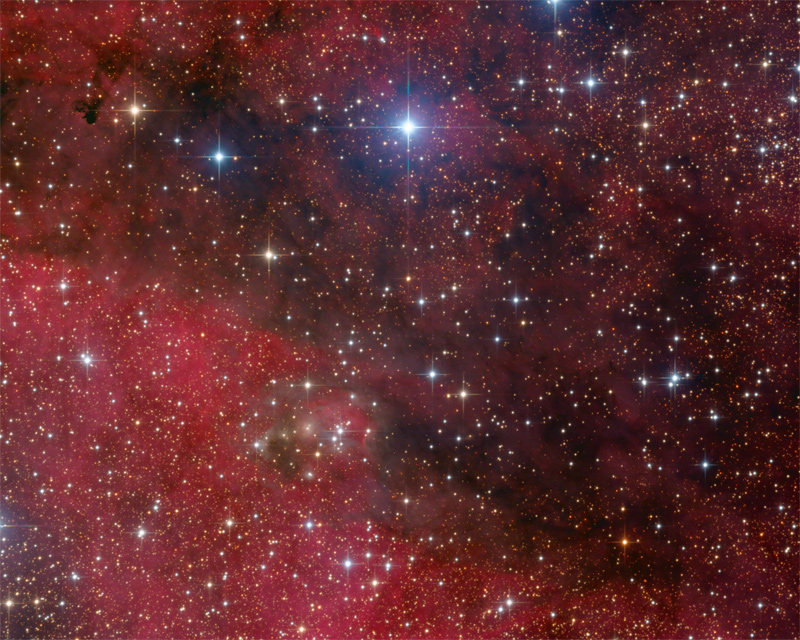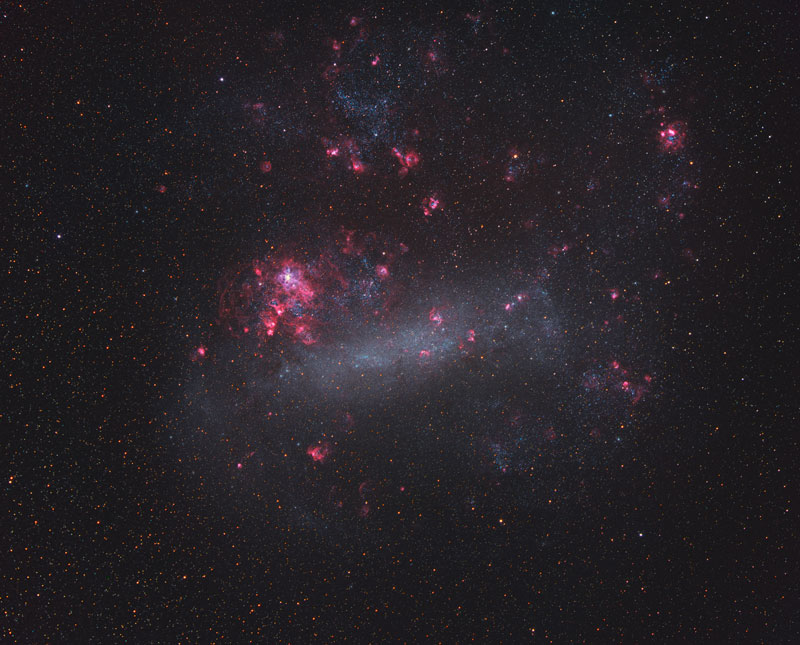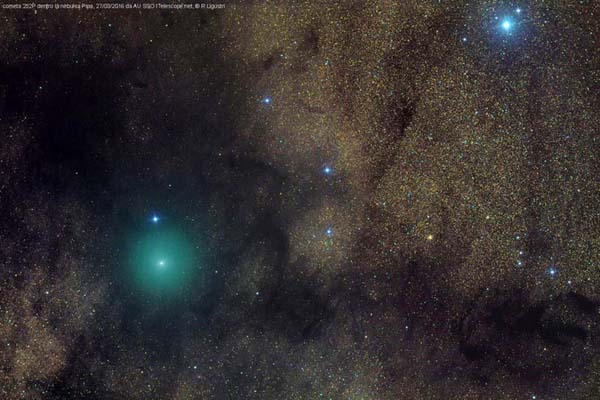Found images: 2016 March
-
starsurfer
- Stellar Cartographer
- Posts: 5409
- Joined: Thu Mar 15, 2012 7:25 pm
-
starsurfer
- Stellar Cartographer
- Posts: 5409
- Joined: Thu Mar 15, 2012 7:25 pm
Re: Found images: 2016 March
RCW 33
http://www.tvdavisastropics.com/astroim ... 000076.htm
Copyright: Thomas Davis The round nebula near the right edge is K2-15, originally catalogued as a planetary nebula but was later found to be an emission nebula.
http://www.tvdavisastropics.com/astroim ... 000076.htm
Copyright: Thomas Davis The round nebula near the right edge is K2-15, originally catalogued as a planetary nebula but was later found to be an emission nebula.
ESO: All Quiet in the Nursery? (LDN 1768)
All Quiet in the Nursery? (LDN 1768)
ESO Picture of the Week | 2016 Mar 21
ESO Picture of the Week | 2016 Mar 21
[img3="Credit: ESO"]http://cdn.eso.org/images/thumb700x/potw1612a.jpg[/img3][hr][/hr]The dark patch snaking across this spectacular image of a field of stars in the constellation of Ophiuchus (The Serpent-bearer) is not quite what it appears to be.
Although it looks as if there are no stars here, they are hidden behind this dense cloud of dust that blocks out their light. This particular dark cloud is known as LDN 1768.
Despite their rather dull appearance, dark nebulae like LDN 1768 are of huge interest to astronomers, as it is here that new stars form. Inside these vast stellar nurseries there are protostars — stars at the earliest stage of their lives, still coalescing out of the gas and dust in the cloud.
Protostars are relatively cold and have not yet begun to produce enough energy to emit visible light. Instead, they emit radiation at submillimetre wavelengths, which human eyes cannot see. Luckily, unlike visible light, light at submillimetre wavelengths is not absorbed by the surrounding dust. By using special telescopes that are sensitive to submillimetre radiation, like the Atacama Large Millimeter/submillimeter Array (ALMA) observatory, we can see through the dust and find out more about the protostars within the cloud.
Eventually, the protostars will become dense and hot enough to start the nuclear reactions that will produce visible light and they will start to shine. When this happens, they will blow away the cocoon of dust surrounding them and cause any remaining gas to emit light as well, creating the spectacular light show known as an HII region. ...
Know the quiet place within your heart and touch the rainbow of possibility; be
alive to the gentle breeze of communication, and please stop being such a jerk. — Garrison Keillor
alive to the gentle breeze of communication, and please stop being such a jerk. — Garrison Keillor
-
starsurfer
- Stellar Cartographer
- Posts: 5409
- Joined: Thu Mar 15, 2012 7:25 pm
-
starsurfer
- Stellar Cartographer
- Posts: 5409
- Joined: Thu Mar 15, 2012 7:25 pm
Re: Found images: 2016 March
NGC 6397
http://www.chart32.de/index.php/component/k2/item/187
Copyright: CHART32
Processing: Bernd Flach-Wilken
http://www.chart32.de/index.php/component/k2/item/187
Copyright: CHART32
Processing: Bernd Flach-Wilken
HEIC: A Cosmic Kaleidoscope (MACS J0416)
A Cosmic Kaleidoscope (MACS J0416)
ESA Hubble Picture of the Week | 2016 Mar 21
http://asterisk.apod.com/viewtopic.php?t=35723
ESA Hubble Picture of the Week | 2016 Mar 21
[img3="Credit: NASA, ESA, CXC, NRAO/AUI/NSF, STScI, and G. Ogrean (Stanford)At first glance, this cosmic kaleidoscope of purple, blue and pink offers a strikingly beautiful — and serene — snapshot of the cosmos. However, this multi-coloured haze actually marks the site of two colliding galaxy clusters, forming a single object known as MACS J0416.1-2403 (or MACS J0416 for short).
Acknowledgment: NASA, ESA, and J. Lotz (STScI), and the HFF team"]http://cdn.spacetelescope.org/archives/ ... w1612a.jpg[/img3][hr][/hr]
MACS J0416 is located about 4.3 billion light-years from Earth, in the constellation of Eridanus. This new image of the cluster combines data from three different telescopes: the NASA/ESA Hubble Space Telescope (showing the galaxies and stars), the NASA Chandra X-ray Observatory (diffuse emission in blue), and the NRAO Jansky Very Large Array (diffuse emission in pink). Each telescope shows a different element of the cluster, allowing astronomers to study MACS J0416 in detail.
As with all galaxy clusters, MACS J0416 contains a significant amount of dark matter, which leaves a detectable imprint in visible light by distorting the images of background galaxies. In this image, this dark matter appears to align well with the blue-hued hot gas, suggesting that the two clusters have not yet collided; if the clusters had already smashed into one another, the dark matter and gas would have separated. MACS J0416 also contains other features — such as a compact core of hot gas — that would likely have been disrupted had a collision already occurred.
Together with five other galaxy clusters, MACS J0416 is playing a leading role in the Hubble Frontier Fields programme, for which this data was obtained. Owing to its huge mass, the cluster is in fact bending the light of background objects, acting as a magnifying lens. Astronomers can use this phenomenon to find galaxies that existed only hundreds of million years after the big bang. ...
http://asterisk.apod.com/viewtopic.php?t=35723
Know the quiet place within your heart and touch the rainbow of possibility; be
alive to the gentle breeze of communication, and please stop being such a jerk. — Garrison Keillor
alive to the gentle breeze of communication, and please stop being such a jerk. — Garrison Keillor
-
starsurfer
- Stellar Cartographer
- Posts: 5409
- Joined: Thu Mar 15, 2012 7:25 pm
-
starsurfer
- Stellar Cartographer
- Posts: 5409
- Joined: Thu Mar 15, 2012 7:25 pm
Re: Found images: 2016 March
Cave Nebula (Sh2-155)
http://www.karelteuwen.be/photo_page.ph ... 2&album=15
Copyright: Karel Teuwen vdB155 is the blue reflection nebula.
http://www.karelteuwen.be/photo_page.ph ... 2&album=15
Copyright: Karel Teuwen vdB155 is the blue reflection nebula.
-
starsurfer
- Stellar Cartographer
- Posts: 5409
- Joined: Thu Mar 15, 2012 7:25 pm
Re: Found images: 2016 March
-
starsurfer
- Stellar Cartographer
- Posts: 5409
- Joined: Thu Mar 15, 2012 7:25 pm
Re: Found images: 2016 March
NGC 3344
http://www.deeplook.astronomie.at/ngc3344_basis.htm
Copyright: Markus Blauensteiner and Günter Kerschhuber
http://www.deeplook.astronomie.at/ngc3344_basis.htm
Copyright: Markus Blauensteiner and Günter Kerschhuber
-
starsurfer
- Stellar Cartographer
- Posts: 5409
- Joined: Thu Mar 15, 2012 7:25 pm
Re: Found images: 2016 March
WLM
http://www.noao.edu/image_gallery/html/im1278.html
Copyright: Local Group Survey Team and T.A. Rector (University of Alaska Anchorage)
http://www.noao.edu/image_gallery/html/im1278.html
Copyright: Local Group Survey Team and T.A. Rector (University of Alaska Anchorage)
-
starsurfer
- Stellar Cartographer
- Posts: 5409
- Joined: Thu Mar 15, 2012 7:25 pm
-
starsurfer
- Stellar Cartographer
- Posts: 5409
- Joined: Thu Mar 15, 2012 7:25 pm
comet 252P "inside" the Pipe nebula
https://picasaweb.google.com/lh/photo/L ... directlinkRolando Ligustri wrote:Interestingly comet, 252P, which near perihelion showed a powerful outburst, increasing its brightness by more than 5 magnitudes, making it visible to the naked eye from the southern skies.Here while "flying over" the Pipe Nebula, this perspective makes it almost 3D the picture.
link for high res, http://www.astrobin.com/243213/
Last edited by bystander on Mon Mar 28, 2016 5:14 pm, edited 1 time in total.
ESO: Beneath the Milky Way
Beneath the Milky Way
ESO Picture of the Week | 2016 Mar 28
ESO Picture of the Week | 2016 Mar 28
[img3="Credit: ESO/Luis Calçada/Herbert Zodet"]http://cdn.eso.org/images/screen/potw1613a.jpg[/img3][hr][/hr]Deep in the Chilean Desert, astronomers staying at ESO’s La Residencia, the VLT Observatory's hotel, witness a skyscape like few others on Earth.
Designed by the German architects Auer+Weber+Assoziierte, La Residencia provides an oasis for those working at ESO’s Paranal Observatory. The Atacama Desert is one of the harshest landscapes imaginable. Extreme dryness, intense ultraviolet radiation from the Sun, and high altitude are a normal part of everyday life. However, come nightfall, La Residencia experiences some of the best observing conditions in the world.
La Residencia and ESO’s Very Large Telescope (VLT) — housed at the Paranal Observatory — are far from sources of light pollution, and experience exceptionally clear atmospheric conditions. On moonless nights, the sky can be so clear and dark that light from the Milky Way casts a shadow on the ground! These factors permit high quality scientific observations to be made as well as offering amazing conditions for astrophotography, exemplified in this stunning shot taken by Luis Calçada, a motion graphic designer at ESO’s headquarters in Garching, Germany.
In this photograph, the plane of the Milky Way can be seen above La Residencia, as passing staff members take a moment to admire the spectacular sight.
Know the quiet place within your heart and touch the rainbow of possibility; be
alive to the gentle breeze of communication, and please stop being such a jerk. — Garrison Keillor
alive to the gentle breeze of communication, and please stop being such a jerk. — Garrison Keillor
HEIC: A Distinctly Disorganised Dwarf Galaxy (UGC 4459)
A Distinctly Disorganised Dwarf Galaxy (UGC 4459)
ESA Hubble Picture of the Week | 2016 Mar 28
ESA Hubble Picture of the Week | 2016 Mar 28
[img3="Image credit: ESA/Hubble & NASADespite being less famous than their elliptical and spiral galactic cousins, irregular dwarf galaxies, such as the one captured in this NASA/ESA Hubble Space Telescope image, are actually one of the most common types of galaxy in the Universe. Known as UGC 4459, this dwarf galaxy is located approximately 11 million light-years away in the constellation of Ursa Major (The Great Bear), a constellation that is also home to the Pinwheel Galaxy (M101), the Owl Nebula (M97), Messier 81, Messier 82 and several other galaxies all part of the M81 group.
Acknowledgement: Judy Schmidt (Geckzilla)"]http://cdn.spacetelescope.org/archives/ ... w1613a.jpg[/img3][hr][/hr]
UGC 4459’s diffused and disorganised appearance is characteristic of an irregular dwarf galaxy. Lacking a distinctive structure or shape, irregular dwarf galaxies are often chaotic in appearance, with neither a nuclear bulge — a huge, tightly packed central group of stars — nor any trace of spiral arms — regions of stars extending from the centre of the galaxy. Astronomers suspect that some irregular dwarf galaxies were once spiral or elliptical galaxies, but were later deformed by the gravitational pull of nearby objects.
Rich with young blue stars and older red stars, UGC 4459 has a stellar population of several billion. Though seemingly impressive, this is small when compared to the 200 to 400 billion stars in the Milky Way!
Observations with Hubble have shown that because of their low masses, star formation is very low compared to larger galaxies. Only very little of their original gas has been turned into stars. Thus, these small galaxies are interesting to study to better understand primordial environments and the star formation process.
Know the quiet place within your heart and touch the rainbow of possibility; be
alive to the gentle breeze of communication, and please stop being such a jerk. — Garrison Keillor
alive to the gentle breeze of communication, and please stop being such a jerk. — Garrison Keillor



